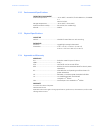CHAPTER 1: INTRODUCTION COMMAND LINE INTERFACE SOFTWARE
MULTILINK ML1600 ETHERNET COMMUNICATIONS SWITCH – INSTRUCTION MANUAL 1–13
To add a user, use the add command as shown below. The user name has to be a unique
name. The password is recommended to be at least 8 characters long with a mix of upper
case, lower case, numbers and special characters.
add user=<name> level=<number>
The following example adds a user “peter” with manager-level privilege:
ML1600# user
ML1600(user)##
add user=peter level=2
Enter User Password:******
Confirm New Password:******
ML1600(user)##
To delete a user, use the delete command as shown below.
delete user=<name>
The following example deletes the user “peter”:
ML1600(user)## delete user=peter
Confirm User Deletion(Y/N): Y
User successfully deleted
ML1600(user)##
The syntax to modify a password is shown below:
passwd user=<name>
The following example changes the password for user “peter”.
ML1600(user)## passwd user=peter
Enter New Password:******
Confirm New Password :******
Password has been modified successfully
ML1600(user)##
The syntax to modify the privilege level for a specific user is shown below:
chlevel user=<name> level=<number>
The following example modifies the privilege level of user “peter” to Operator privileges.
ML1600(user)## chlevel user=peter level=1
Access Permission Modified
ML1600(user)##
The syntax to set the access privileges for telnet and Web services is shown below:
useraccess user=<name> service=<telnet|web> <enable|disable>
The following example sets the access privileges for telnet and Web services.
ML1600(user)## useraccess user=peter service=telnet disable
Telnet Access Disabled.
1.5.9 Help
Typing the help command lists the commands you can execute at the current privilege
level. For example, typing
help at the Operator level shows the following:
ML1600> help


















